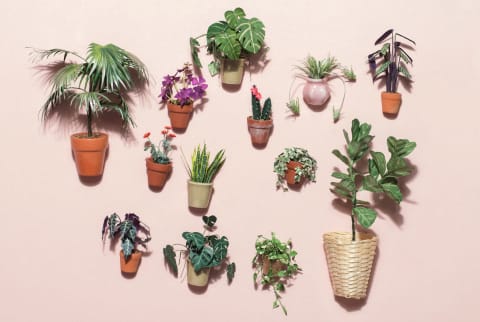Advertisement
How To Up Your Plant Game This Spring — For Next-To-No $$


Houseplants can be an expensive habit. They're kind of like tattoos, after all: Once you get your first one, you're hooked for life. For all you plant parents on a budget out there, we reached out to some experts to find out how to save money on your indoor jungle.
1. Remember that candle jars make free planters.
"I like to recycle used candles as planters, especially the fancy gift ones that come in glass jars," says Erin Marino of The Sill, a popular online plant destination with storefronts in New York and LA. It's easy to do. Once the candle is finished, she soaks the container in warm, soapy water overnight and then scrubs out any leftover wax. Depending on the material, she'll run it through the dishwasher once or twice too. "Because there's no drainage hole and I'm not handy with a drill, I line the bottom of the candle container with lava rocks before adding potting mix and my plant."
2. Hop on the propagation bandwagon.
Marino also propagates plants to save money, saying that some of her favorite species are some of the easiest to multiply. "Pothos and heart-leaf philodendron are both trailing plants that grow incredibly fast and can be propagated in water. Simply snip off a couple of inches of healthy stem right before a node—and make sure to include a node or two with the cutting, as this is where the new growth will come from," she explains.
3. Place your plants strategically.
When you invest in a new plant, make sure you're getting bang for your buck by placing it in an area where it can live a good, long life. Pro tip: Brittany Gowan, creator of the popular #PauseWithPlants hashtag, says that Pothos and Sansevieria are the ultimate inexpensive plant duo, and placing them next to each other will help them both grow faster: "To speed up growth, allow the leaves of the Pothos to grow among the Sansevieria. These two plants easily add attractive height and width to your houseplant collection."
4. Never underestimate the versatility of a terra-cotta pot.
"Cheap terra-cotta pots from the hardware store are perfect for potting, and if they don't match your color palette, they can be easily painted," says Maggie Bailey of Floom, an online plant shop that delivers to LA, NYC, SF, Chicago, and now Houston. "Dress them up with a layer of moss or pebbles over the top of the soil."
5. Organize a plant swap.
Think clothing swap but for plants! Get a few friends together and have everyone bring at least one plant that they're willing to part ways with. Summer Rayne Oakes, environmentalist and author of the upcoming book How To Make a Plant Love You, hosts them on a larger scale in New York and Los Angeles and has noticed they cultivate a strong sense of community too. "Swapping with friends and strangers is honestly one of the most affordable ways to get new plants. In addition to that," she says, "you often build a connection with the people you trade with when you otherwise wouldn't."